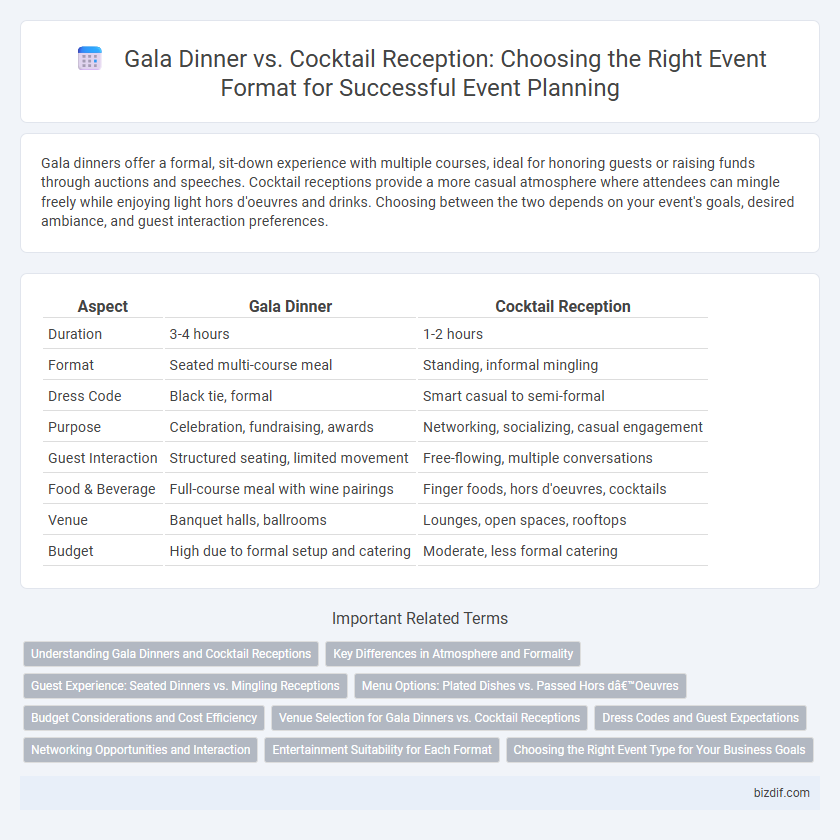Gala dinners offer a formal, sit-down experience with multiple courses, ideal for honoring guests or raising funds through auctions and speeches. Cocktail receptions provide a more casual atmosphere where attendees can mingle freely while enjoying light hors d'oeuvres and drinks. Choosing between the two depends on your event's goals, desired ambiance, and guest interaction preferences.
Table of Comparison
| Aspect | Gala Dinner | Cocktail Reception |
|---|---|---|
| Duration | 3-4 hours | 1-2 hours |
| Format | Seated multi-course meal | Standing, informal mingling |
| Dress Code | Black tie, formal | Smart casual to semi-formal |
| Purpose | Celebration, fundraising, awards | Networking, socializing, casual engagement |
| Guest Interaction | Structured seating, limited movement | Free-flowing, multiple conversations |
| Food & Beverage | Full-course meal with wine pairings | Finger foods, hors d'oeuvres, cocktails |
| Venue | Banquet halls, ballrooms | Lounges, open spaces, rooftops |
| Budget | High due to formal setup and catering | Moderate, less formal catering |
Understanding Gala Dinners and Cocktail Receptions
Gala dinners are formal events characterized by a full-course meal, structured seating arrangements, and a focus on ceremonial activities such as award presentations or speeches, often accompanied by live entertainment. Cocktail receptions prioritize a more informal atmosphere, featuring standing gatherings where guests mingle and enjoy a variety of hors d'oeuvres and mixed drinks, facilitating networking and social interaction. Understanding these differences helps event planners tailor the guest experience and logistical planning to match the intended event tone and objectives.
Key Differences in Atmosphere and Formality
Gala dinners feature a structured, formal atmosphere with assigned seating and multi-course meals, emphasizing elegance and a dress code often including black tie attire. Cocktail receptions offer a more relaxed, social environment with open mingling, standing hors d'oeuvres, and casual or semi-formal dress, promoting interaction over formality. The ambiance of gala dinners is designed to impress and celebrate with grandeur, while cocktail receptions focus on networking and accessibility.
Guest Experience: Seated Dinners vs. Mingling Receptions
Seated gala dinners provide guests with a structured, formal dining experience that encourages in-depth conversations and personalized service, enhancing comfort and elegance. Cocktail receptions promote dynamic mingling opportunities, allowing guests to socialize freely and network in a relaxed atmosphere with light refreshments and standing arrangements. Optimal guest experience depends on event objectives, with gala dinners fostering intimacy and cocktail receptions encouraging interaction.
Menu Options: Plated Dishes vs. Passed Hors d’Oeuvres
Gala dinners typically feature plated dishes offering a structured, multi-course meal that allows for elegant presentation and a refined dining experience, often including options like filet mignon, seafood, and gourmet sides. Cocktail receptions prioritize passed hors d'oeuvres, which provide a variety of bite-sized, easily consumable options such as mini quiches, shrimp cocktails, and artisanal cheeses, encouraging mingling and social interaction. These menu choices influence the event's style, pacing, and guest experience, with plated meals promoting formality and hors d'oeuvres supporting a casual, dynamic atmosphere.
Budget Considerations and Cost Efficiency
Gala dinners typically demand higher budgets due to formal sit-down dining, extensive decor, and entertainment costs, making them less cost-efficient compared to cocktail receptions. Cocktail receptions offer flexibility with buffet-style or finger foods, reducing staffing and venue expenses while promoting social interaction. Budget planners must weigh guest experience against financial constraints to choose an event style that maximizes value and impact.
Venue Selection for Gala Dinners vs. Cocktail Receptions
Gala dinners typically require spacious venues with formal dining arrangements, such as ballrooms or banquet halls, that can accommodate seated meals and elaborate decor. Cocktail receptions favor versatile spaces like rooftops, lounges, or art galleries that promote mingling and standing-room mingling with high-top tables and open layouts. Selecting the right venue depends on event goals, guest capacity, and ambiance, with gala dinners demanding elegant, structured environments while cocktail receptions emphasize casual, social atmospheres.
Dress Codes and Guest Expectations
Gala dinners typically require formal dress codes such as black tie or evening gowns, setting a tone of elegance and sophistication that guests expect for a more structured and upscale event. Cocktail receptions favor semi-formal or cocktail attire, encouraging a stylish yet relaxed atmosphere conducive to mingling and casual conversation. Understanding these dress code distinctions helps event planners align guest expectations with the event's ambiance and dress standards.
Networking Opportunities and Interaction
Gala dinners offer structured networking with seated arrangements that encourage in-depth conversations, fostering meaningful professional relationships. Cocktail receptions provide a dynamic environment where guests circulate freely, maximizing casual interactions and expanding networking potential. Choosing between the two depends on whether the goal is focused dialogue or broad social engagement.
Entertainment Suitability for Each Format
Gala dinners offer a more formal setting ideal for classical music, live bands, or keynote speakers that engage guests during seated dining. Cocktail receptions suit dynamic entertainment like DJs, interactive performers, and standing music groups that encourage mingling and social interaction. Choosing entertainment tailored to the event's ambiance enhances guest experience and event flow.
Choosing the Right Event Type for Your Business Goals
Selecting between a gala dinner and a cocktail reception hinges on your business objectives and desired attendee engagement. Gala dinners, with formal seating and structured programs, enhance brand prestige and facilitate in-depth networking, ideal for fundraising or award ceremonies. Cocktail receptions offer a more casual atmosphere promoting dynamic socializing and broader mingling, suitable for product launches or client appreciation events.
Gala dinner vs Cocktail reception Infographic

 bizdif.com
bizdif.com